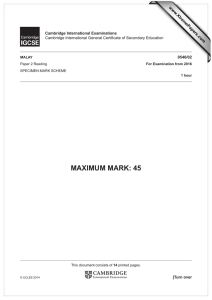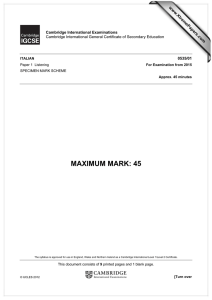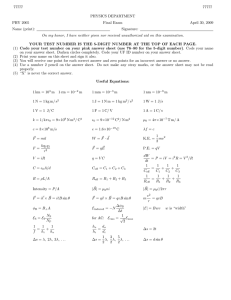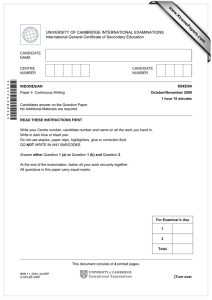www.XtremePapers.com
advertisement
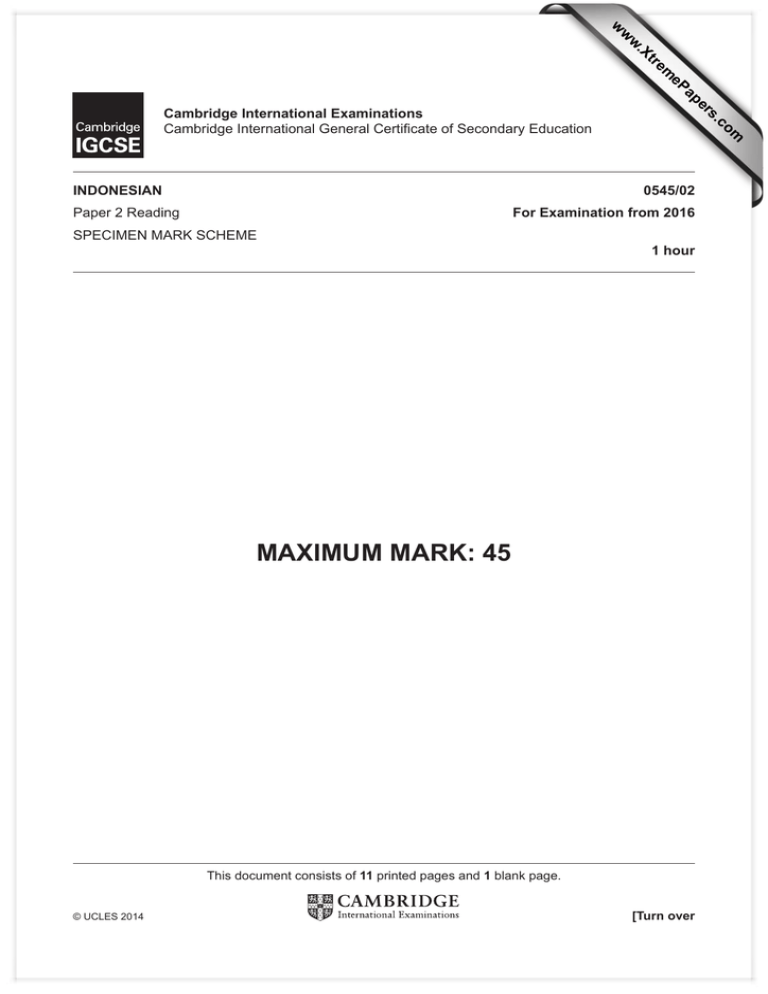
w w ap eP m e tr .X w om .c INDONESIAN s er Cambridge International Examinations Cambridge International General Certificate of Secondary Education 0545/02 Paper 2 Reading For Examination from 2016 SPECIMEN MARK SCHEME 1 hour MAXIMUM MARK: 45 This document consists of 11 printed pages and 1 blank page. © UCLES 2014 [Turn over 2 1 General Marking Principles 1.1 Please note that it is not possible to list all acceptable alternatives in the Detailed Mark Scheme provided in Section 2. Examiners will consider all alternative answers and unexpected approaches in candidates’ scripts and make a decision on whether they communicate the required elements. The following marking principles underpin the detailed instructions provided in Section 2 of the Mark Scheme. Where a decision is taken to deviate from these principles for a particular question, this will be specified in the Mark Scheme. 1.2 Crossing out: (a) If a candidate changes his/her mind over an answer and crosses out an attempt, award a mark if the final attempt is correct. (b) If a candidate crosses out an answer to a whole question but makes no second attempt at it, mark the crossed out work. 1.3 More than the stipulated number of boxes ticked/crossed by the candidate: (a) If more than one attempt is visible, but the candidate has clearly indicated which attempt is his/ her final answer (e.g. by crossing out other attempts or by annotating the script in some way), mark in the usual way. (b) If two attempts are visible (e.g. 2 boxes ticked instead of the 1 box stipulated), and neither has been crossed out/discounted by the candidate, no mark can be awarded. (c) In questions where candidates are required to tick a number of boxes (e.g. tick the 6 true statements) the general rule to be applied is as follows: the number of ‘extra’ answers indicated by the candidate is deducted from the number of correct answers and the remaining number is the mark awarded. For example, the candidate is required to tick 6 true statements, but instead ticks 8 statements. 5 of the ticks are correctly placed, but there are 2 ‘extra’ ticks (8 ticks placed by candidate minus 6 ticks required by rubric = 2 ‘extras’). Therefore the candidate is awarded a mark of 3 number of correct ticks: 5 minus number of extra ticks: –2 mark awarded: =3 (d) Answers in pen do not take precedence over answers in pencil, e.g. if a candidate is asked to tick 1 box and ticks 2, one in pen and the other in pencil, the mark cannot be awarded unless there is some explicit indication from the candidate as to which is his/her final answer. 1.4 For questions requiring more than one element for the answer, (i) and (ii), where the answers are interchangeable: Both correct answers on line 1, and line 2 blank = 2 Both correct answers on line 1, and line 2 wrong = 1 (or vice-versa) © UCLES 2014 0545/02/SM/16 3 1.5 Answers requiring the use of Indonesian (rather than a non-verbal response) should be marked for communication. Tolerate inaccuracies, provided the message is clear. (a) ‘If in doubt, sound it out’: if you read what the candidate has written, does it sound like the correct answer? (b) Look-alike test: does what the candidate has written look like the correct answer? 1.6 Unless the Mark Scheme specifies otherwise, do not accept incorrect Indonesian if the word given means something else in Indonesian. (Incorrect Indonesian which constitutes a word in any language other than Indonesian is marked (i) on the basis of whether it is accepted or refused in the Mark Scheme, and (ii) if not mentioned in the Mark Scheme, on the basis of 1.5 above.) 1.7 Annotation used in the Mark Scheme/Marking: (a) INV = Invalidation and is used when additional material included by the candidate is judged to invalidate an otherwise correct answer thus preventing him/her from scoring the mark (INV = 0). (b) tc = ‘tout court’ and means that on its own the material is not sufficient to score the mark. (c) HA = harmless additional material which in conjunction with the correct answer does not prevent the candidate from scoring the mark. (d) BOD = Benefit of the Doubt and is used to indicate material considered by the Examiner and judged to be more correct than incorrect: the benefit of the doubt is given to the candidate and the mark is awarded. © UCLES 2014 0545/02/SM/16 [Turn over 4 1.9 Extra material: Section 2, Exercise 2 In Section 2, Exercise 2, reward the candidate for being able to locate the answer in the passage. Do not worry about lifting unless a lift is specifically rejected in the Mark Scheme. Unless the Mark Scheme states otherwise, ignore extra material given in an answer. 1.10 Extra material: Section 3 In Section 3 it is the candidate’s responsibility to answer questions in such a way as to demonstrate to the Examiner that s/he has understood the texts/questions. Where candidates introduce extra, irrelevant material to an otherwise correct answer the danger is that the Examiner is being forced to ‘choose’ the correct answer and s/he cannot be certain that the candidate has shown understanding. Where the Examiner is put in this position the mark cannot be awarded. In Section 3, look for signs of genuine comprehension. Usually, candidates who lift indiscriminately fail to demonstrate comprehension and will not score the mark. However, careful lifting of the details required to answer the question does demonstrate comprehension and should be rewarded. The Detailed Mark Scheme (Section 3) provides specific guidance but in cases not covered, the following general rules apply: (a) Extra material, mentioned in the Mark Scheme, which reinforces the correct answer or in itself constitutes an alternative correct answer: this is acceptable and is not penalised (b) Extra material which constitutes an alternative answer, but which is not explicitly mentioned in the Mark Scheme: the Examiner needs to decide whether the alternative answer constitutes: (i) an alternative correct answer, in which case this falls into category (a) and the answer should be rewarded or (ii) an answer which on its own would be refused, in which case this falls into category (c) and the answer should be refused this puts the Examiner in the position of having to ‘choose’ which is the candidate’s ‘final’ answer – the Examiner cannot be sure what the candidate has understood – and the mark cannot be awarded (c) Extra material which constitutes an alternative answer specifically refused in the Mark Scheme: (d) Extra material which distorts or this affects communication – the Examiner cannot be contradicts the correct answer: sure what the candidate has understood – and the mark cannot be awarded (e) Extra material introduced by the candidate and which does not feature in the text: © UCLES 2014 this affects communication – the Examiner cannot be sure what the candidate has understood – and the mark cannot be awarded. 0545/02/SM/16 5 2 Detailed Mark Scheme Section 1 Exercise 1 Questions 1–5 ACCEPT REFUSE 1 A [1] 2 D [1] 3 D [1] 4 B [1] 5 C [1] [Total: 5] Exercise 2 Questions 6–10 REFUSE ACCEPT 6 C [1] 7 D [1] 8 E [1] 9 F [1] 10 A [1] [Total: 5] Exercise 3 Questions 11–15 ACCEPT REFUSE 11 A [1] 12 B [1] 13 A [1] 14 B [1] 15 C [1] [Total: 5] © UCLES 2014 0545/02/SM/16 [Turn over 6 Section 2 Exercise 1 Questions 16–20 ACCEPT REFUSE 16 indah [1] 17 sedikit [1] 18 anak-anak [1] 19 toko [1] 20 mobil-mobil [1] [Total: 5] Exercise 2 Questions 21–29 • In this exercise, reward the candidate for being able to locate the answer in the passage. Ignore extra material (whether Indonesian is accurate or inaccurate) unless the Mark Scheme specifies otherwise. • Accept lifting unless it is specifically refused in the Mark Scheme. • Read Section 1: General Marking Principles. ACCEPT REFUSE 21 KEY CONCEPT: spend the holidays [1] ‘naik’ tc but HA (incomplete) Untuk mengajaknya berlibur/naik gunung ‘Untuk mengajak kamu berlibur dengan saya.’ bersama 22 KEY CONCEPT: climb Mount Bromo naik Gunung Bromo [1] pergi ke gunung-gunung (need idea of walk) “Bapak saya ingin naik Gunung Bromo pada bulan Juli” 23 KEY CONCEPT: go with [1] pergi dengan Harto (if Harto is mentioned, check answer carefully) - apakah dia boleh ikut pergi - mau ikut pergi dengan bapak - mau menemani bapak 24 KEY CONCEPT: difficult hike “karena saya senang naik gunung, saya bertanya kepada bapak apakah saya boleh ikut” [1] dia mengira jalan itu sulit tc (need hike) dia berpendapat bahwa gunung Bromo terlalu tinggi untuk Seno. terlalu tinggi tc jalan terlalu tc OR “Dia mengatakan gunung itu terlalu tinggi untuk kamu.” not strong enough Seno tidak cukup kuat untuk mendaki gunung Bromo © UCLES 2014 0545/02/SM/16 7 ACCEPT REFUSE 25 KEY CONCEPT: Seno naik gunung di dekat rumahnya [1] naik gunung tc 26 KEY CONCEPTS: [1] “saya akan cukup kuat untuk naik gunung.” EITHER “kemarin saya mendaki gunung di dekat rumah kami.” Dia berhasil naik gunung. (tc) - Seno berhasil naik gunung di dekat rumahnya -karena dia/Seno bisa melakukan/ menyelesaikan perjalanan itu OR - Seno akan mampu/bisa melakukan/ menyelesaikan perjalanan di gunung/pada bulan Juli OR Seno akan dapat ikut melakukan perjalanan di gunung /pada bulan Juli. OR dia percaya saya akan cukup kuat untuk naik gunung Bromo. 27 KEY CONCEPT: invite Harto / invite friend “Pada waktu kami makan malam bersama, [1] bapak punye ide yang bagus” tc Menyuruh Seno untuk mengajak Harto berlibur bersama Ide yang bagus/hebat pergi dengan Harto (no idea of “invite”) Dia berkata “Seno, ajak teman kamu Harto untuk ikut dalam perjalanan pada bulan Juli nanti. Pasti kamu akan lebih senang.” 28 KEY CONCEPT: 10 days Harto akan ikut (no idea of “invite”) Menyuruh saya untuk mengajak Harto. [1] sepuluh or 10 tc “Kami berencana akan berangkat pada tanggal 15 Juli selama sepuluh hari” any other length of time or “Kami berencana akan berangkat pada tanggal 15 Juli.” 29 (i) KEY CONCEPT: tent [1] “Bapak akan membawa tenda” “Dapatkah kamu membawa tenda untuk kita berdua?” (ii) KEY CONCEPT: map “jika kamu masih punya peta bagus daerah itu, tolong dibawa juga” [1] “Juga, kalau kamu masih punya peta bagus daerah itu, tolong dibawa juga. Peta itu pasti akan berguna sekali.” NB 2 correct answers on line 1, line 2 blank = 2; 2 correct answers on line 1, line 2 wrong = 1 (or vice versa) [Total: 10] © UCLES 2014 0545/02/SM/16 [Turn over 8 Section 3 Look for signs of genuine comprehension. Usually, candidates who lift indiscriminately fail to demonstrate comprehension and will not score the mark. However, careful lifting of the details required to answer the question does demonstrate comprehension and should be rewarded. The Detailed Mark Scheme provides specific guidance but in cases not covered, see Section 1: General Marking Principles. Exercise 1 Questions 30–34 1 Mark per question for True or False 1 Mark for correcting False statement (30, 31, 34) First award marks for the True/False element and then award marks for the justification of the False statements TRUE FALSE 30 9 [1] 31 9 [1] 32 9 [1] 33 9 [1] 34 © UCLES 2014 9 [1] 0545/02/SM/16 9 ACCEPT: CHECK FALSE IS TICKED REFUSE MERE ADDITION OF NEGATIVE 30 CONCEPT is either: [1] SHE HELPS PEOPLE WHO HAVE A HARDER LIFE pada umur 55, Susi memutuskan untuk membantu orang di negara yang penduduknya punya kehidupan yang sulit Dia memutuskan untuk pergi membantu orang yang tinggal di negara miskin/sedang berkembang/ dunia ketiga (or equivalent) or SHE JOINED DOCTORS OF THE WORLD dia menjadi anggota/ikut organisasi “Dokterdokter sedunia” dengan demikian dia menjadi anggota Dokterdokter Dunia or SHE TAKES PART IN HUMANITARIAN ACTION dia berpartisipasi dalam kegiatan kemanusiaan 31 SHE TRAINED [1] “Misi pertama Susi di Mali, Afrika barat. Di situ dia melatih orang-orang muda yang ingin dia melatih orang muda yang ingin menjadi menjadi dokter.” dokter pelatihan tc dia memberi keterangan (wrong message) dia membantu orang muda yang ingin menjadi dokter (incomplete) 34 CONCEPT is either: [1] mereka memilih apa yang terburuk (refuse: this is merely the negative of the statement in the question) THEY REFUSE MODERN MEDICINE / DOCTORS mereka/orang tua “menolak pengobatan modern (yang lebih bagus/lebih efectif)” mereka menolak pengobatan yang lebih baik (yang lebih efektif) or THEY CHOOSE / PREFER TRADITIONAL MEDICINE / DOCTORS mereka/orang tua “kadang-kadang memilih obat tradisional / orang tua lebih suka obat tradisional (yang lebih buruk/kurang efektif)” ACCEPT: “kadang-kadang orang tua memilih obat tradisional dan menolak pengobatan modern yang dapat membantu anak mereka” [Total: 8] © UCLES 2014 0545/02/SM/16 [Turn over 10 Exercise 2 Questions 35–40 ACCEPT REFUSE 35 (A) COLLEAGUE ASKS HIM/TO REPLACE ia bekerja untuk sebuah majalah tc HIS FRIEND [1] “dia bahagia ketika pada suatu hari rekannya minta Nyoman menggantikannya Untuk menggantikan temannya / seorang pergi ke Amazon” rekan minta dia pergi “seorang rekan minta Nyoman menggantikannya pergi ke Amazon” 36 CONCEPT is either: [1] “jauh dari kota dan tempat-tempat turis, Nyoman menemukan lingkungan alam indah yang masih liar.” FAR FROM TOWNS jauh dari kota dan tempat-tempat turis di Amazon (in the Amazon = INV) or FAR FROM TOURIST SITES ACCEPT: jauh dari kota dan tempat-tempat turis “di Amazon jauh dari kota dan tempat-tempat turis” (in the Amazon = INV) di tengah hutan INV Or Jauh dari kota dan tempat-tempat turis dia/ Nyoman menemukan pemandangan yang indah Or Dia/Nyoman menemukan pemandangan yang indah di tempat/daerah yang jauh dari kota dan tempat-tempat turis. 37 CONCEPT is either: THE TREES HAVE BEEN CUT DOWN Penebangan pohon-pohon (deforestasi) [1] “Banyak bencana di mana-mana; pohon-pohon ditebang dan hutan rusak. Nyoman mengambil beratus-ratus foto; dia ingin memperlihatkan kepada kita semua yang terjadi.” mereka akan menebang pohon-pohon di situ Or orang-orang sudah menebang pohon-pohon/ deforestasi or THE FOREST HAS DISAPPEARED deforestasi ACCEPT: “Banyak bencana di mana-mana; pohon-pohon ditebang dan hutan rusak.” © UCLES 2014 0545/02/SM/16 11 ACCEPT REFUSE 38 PROTECT THE WILD REGIONS [1] menciptakan sebuah organisasi = INV dia akan berusaha melindungi daerah-daerah liar dunia untuk menghormati/lingkungan (needs “wild regions”) Or dia akan berusaha melindungi daerah-daerah liar dunia, bagaimanapun caranya» Or untuk melindungi daerah-daerah liar di dunia Accept lifting “Ketika dia ke Indonesia, dia mengambil keputusan: dia akan berusaha melindungi daerah-daerah liar di dunia, bagaimanapun caranya.” 39 (a) YOUNG PEOPLE [1] “Orang-orang muda khususnya harus belajar untuk menghormati lingkungan” orang-orang muda (b) (CREATE) THE BEST ENVIRONMENTAL “Setiap tahun organisasi itu memberi hadiah PROJECT [1] kepada orang yang mengadakan proyek lingkungan hidup yang terbaik.” mengadakan proyek lingkungan hidup untuk menciptakan suatu proyek lingkungan yang terbaik yang luar biasa (not necessarily the best) “memberi hadiah kepada orang yang mengadakan proyek lingkungan hidup yang terbaik.” [1] “Pemuda itu harus sehat dan tidak takut mengambil risiko. Nyoman yang memenuhi syarat-syarat itu dan senang bepergian memerankan ‘pemuda’ tersebut.” 40 Any 1 of • dia sehat • dia tidak takut mengambil risiko • hobinya berjalan-jalan / melakukan perjalanan • dia memiliki semua sifat ini / dia memiliki sifat-sifat yang diperlukan dia punya sifat itu Karena dia sehat, tidak takut mengambil risiko dan suka bepergian [Total : 7] © UCLES 2014 0545/02/SM/16 12 BLANK PAGE © UCLES 2014 0545/02/SM/16
